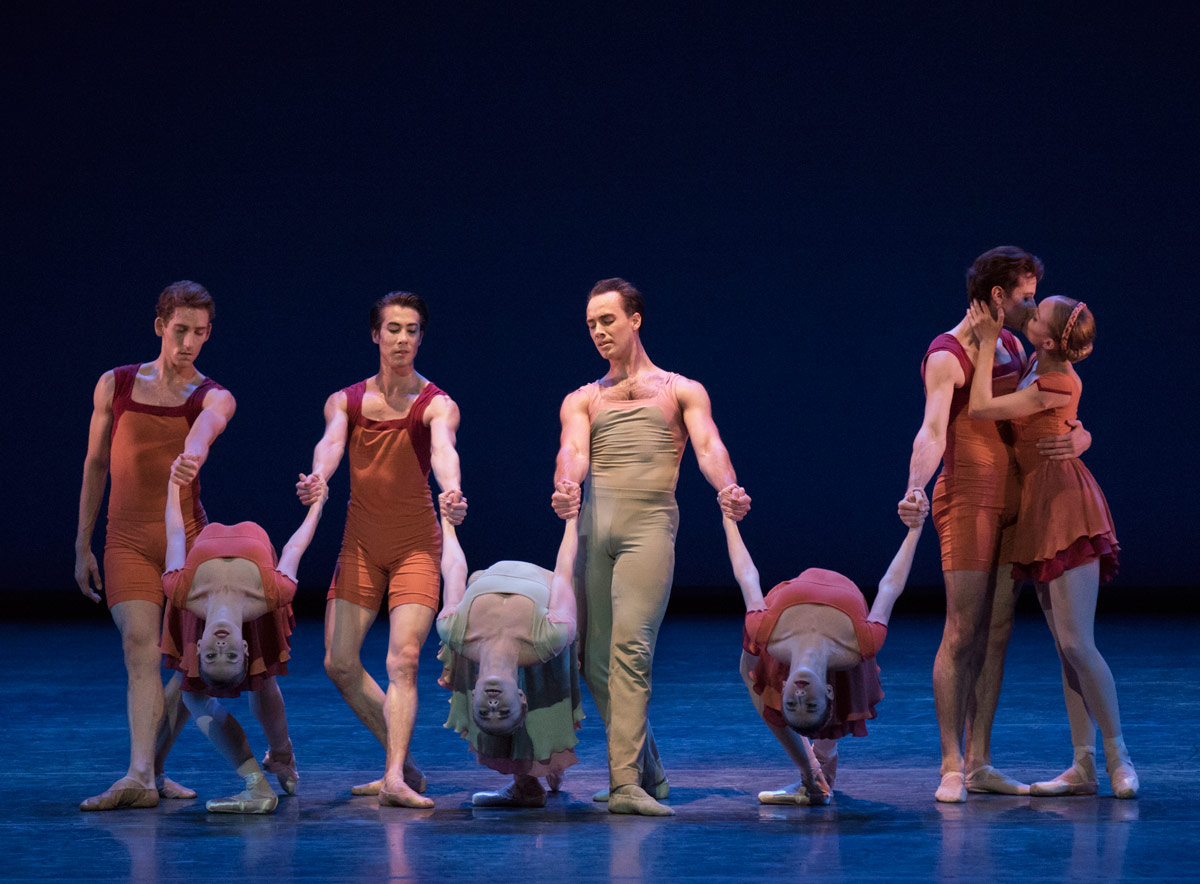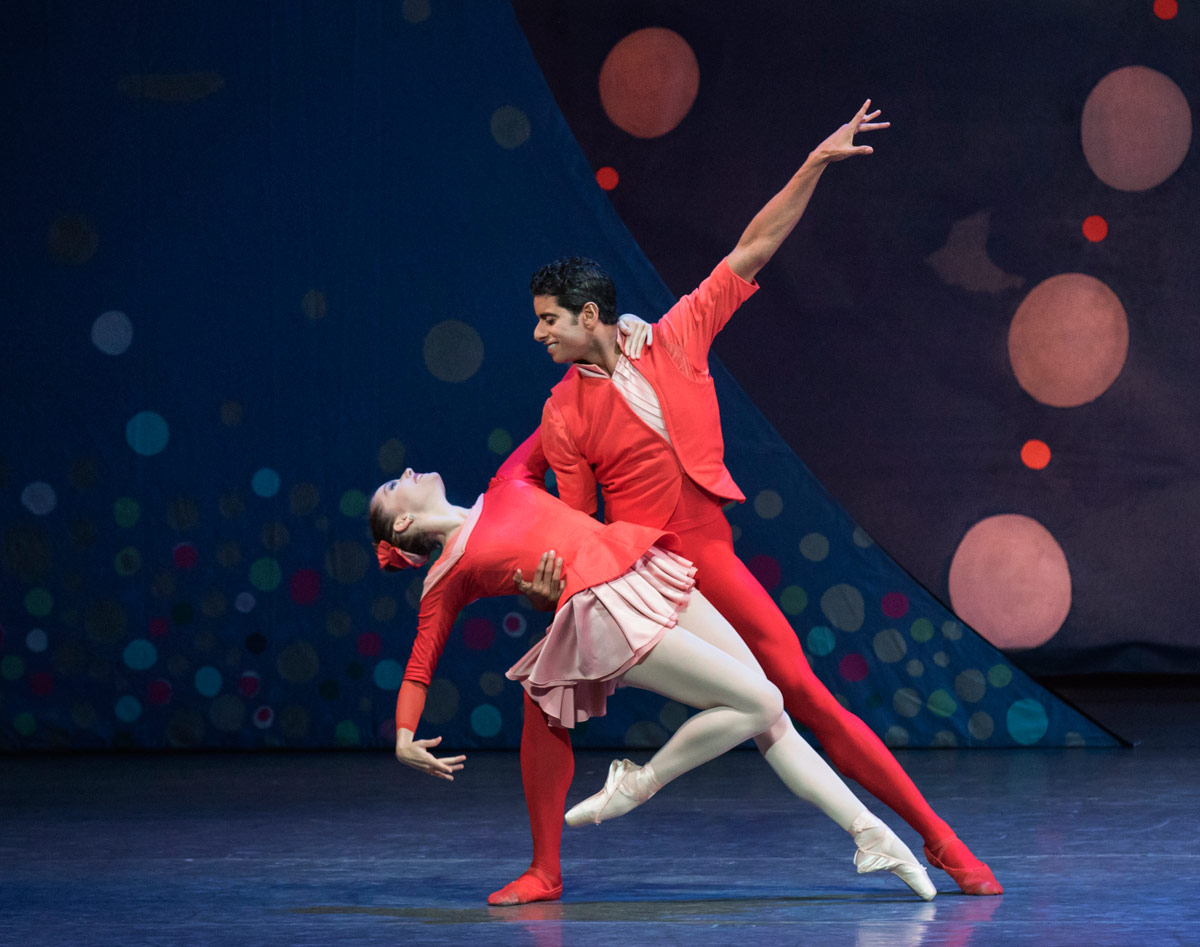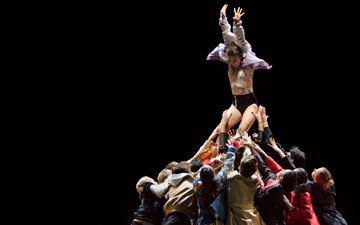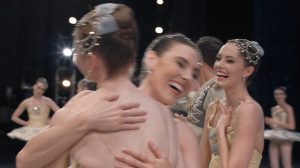
© Paul Kolnik. (Click image for larger version)
New York City Ballet
Spring Gala: “Rain,” from The Concert, Concerto DSCH, Mothership, American Rhapsody
★★★✰✰
New York, David H. Koch Theater
4 May 2016
www.nycballet.com
davidhkochtheater.com
Broadway Melody
It wouldn’t be spring without ballet galas. This week it was New York City Ballet’s turn. On the program were two new works, by Christopher Wheeldon and the relatively unknown Nicolas Blanc, the latter a veteran of the New York Choreographic Institute. (That’s NYCB’s incubator for young choreographers.) The festivities included a champagne reception on the promenade, two short films, and a too-long introduction to the music used in Wheeldon’s ballet, Gershwin’s Rhapsody in Blue. Musical introductions are great, but this one was ill-timed; the crowd was restless to get on with the show… and the party.

© Paul Kolnik. (Click image for larger version)
One of the films was all about the making of An American in Paris, Wheeldon’s Broadway musical, which opened in New York last year and is still going strong. The connection was, of course, that both the musical and Wheeldon’s new ballet are set to Gershwin and star the genial Robert Fairchild. The gesture toward Broadway, a plea for crossover appeal, was a little obvious, but a company’s got to do what a company’s got to do. The other was a tribute to the chairman of its board of directors, Jay Fishman, who suffers from ALS.
As often happens, the older works turned out to be better than the new ones. The first half opened with a little excerpt from Jerome Robbins’ comic ballet The Concert, followed by Alexei Ratmansky’s Concerto DSCH, from 2008. Robbins’s umbrella dance, set to Chopin’s Prelude in E-Minor, is based on a little jewel of an idea. Dancers walk across the stage, carrying umbrellas, opening and closing them as the music rises and falls. In honor of Mr. Fishman, the last umbrella opened was red, the color of the corporation he headed for eleven years, The Travelers Companies. Ballet and commerce, hand in hand.

© Paul Kolnik. (Click image for larger version)
Eight years after its unveiling, Concerto DSCH hasn’t lost its punch. It was one of the first works the Russian-born Ratmansky made in New York, and it still has a freshness and energy that suggest an artist delighted at his discovery of a brave new world. New dancers, a new way of moving, a hunger for speed. Set to Shostakovich’s teasing second piano concerto (brilliantly played by Susan Walters), it races toward its conclusion, bubbling over with inside jokes and playful jostling. Something is always happening in the margins; if you’re lucky enough to pay attention at just the right moment, you’ll catch it. At one point, Ratmansky even plays with time: three dancers duke it out in slow motion while everyone else around them looks sped up.
The new ballets came in the second half. Nicolas Blanc is a former San Francisco Ballet dancer, now a ballet master at The Joffrey Ballet. His Mothership (named after the orchestral work by the young composer Mason Bates to which it is set) turned out to be relatively slight, with a lot of acrobatic partnering – bring on the splits! – and special effects. Stop action, noodle-like voguing arms, slides, attitude-filled poses. The music, composed for the YouTube Symphony Orchestra, a group of musicians assembled via the Internet, contains a mix of electronic and acoustic sounds. It’s big, jazzy, and dominated by a thumping electronic rhythm. The best thing about the ballet, it turned out, was the fact that it featured eight young dancers, three of them still apprentices, who would normally be stuck somewhere in the back of the corps. Given the opportunity to shine, they threw themselves into the movement. (The work was originally developed at the Choreographic Institute, on students from the school.) Christopher Grant, in particular, seemed to be having a ball.

© Paul Kolnik. (Click image for larger version)
Then came the main event: Christopher Wheeldon’s American Rhapsody. Gershwin’s Rhapsody in Blue was played with impressive attack by Cameron Grant in the pit. The conductor was Rob Fisher, responsible for the Gershwin orchestrations in American in Paris. The monumental backdrop, suggesting bubbles and waves encircling a glowing sun, was executed by the Cuban artist Leslie Sardinias. It’s a big, flashy production, as close as NYCB gets to Broadway pizzaz.
In a way American Rhapsody is like those dream ballets in old Hollywood movies. There is a quest. A boy dressed in turquoise (Robert Fairchild) seeks an elusive girl, also dressed in turquoise. (The pretty, but not-terribly flattering costumes are by Janie Taylor.) He searches and searches for her, in vain, making jazzy moves, swiveling his knees or moping around moonily. After a year on Broadway, Fairchild’s charm has only increased, and he has learned how to project emotion with his face, especially his eyes. The girl (Tiler Peck) doesn’t know he’s out there looking for her. And then, finally, they meet, center stage, and lightning strikes. Cue the pas de deux.
The search is complicated by the presence of another couple (Amar Ramasar and Unity Phelan) dressed in red. The corps is in blue. Sometimes Fairchild dances with Ramasar, the high-spirited sidekick. (Ramasar makes the most of the buoyant choreography Wheeldon has created for him, sailing across the stage. He’s a scene-stealer.) Meanwhile, Peck and Phelan engage in some friendly and slightly competitive mirrored duets.

© Paul Kolnik. (Click image for larger version)
There are a couple of intriguing pas de trois along the way, suggesting other possible romantic outcomes. Then, almost as if by chance, the two protagonists meet. Their duet is infused with hints of ballroom dancing and jazz: one-handed partnering, hip-rolls, wrist circles. Wheeldon even throws in a movement of the leg that has become something of a Peck specialty: an extra slow, voluptuous closing of the leg to the knee. The two have always had a good chemistry onstage (they’re also married), and they are both at their best conveying syncopation, jagged rhythms, and off-kilter movement.
Around them, the corps forms decorative friezes, with dancers suspended in mid-air, linked to others pliéing or reclining on the ground. The piece is well-made. It follows the structure of the music faithfully; when you hear something, you’re sure to see it reflected onstage. Well-made, but not terribly inspired. Just right for a gala.

















You must be logged in to post a comment.